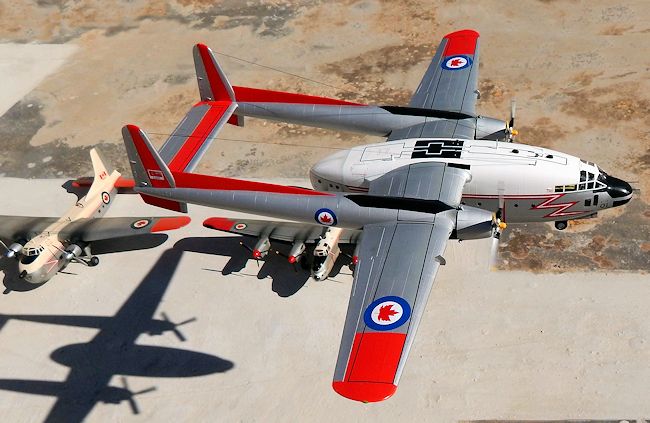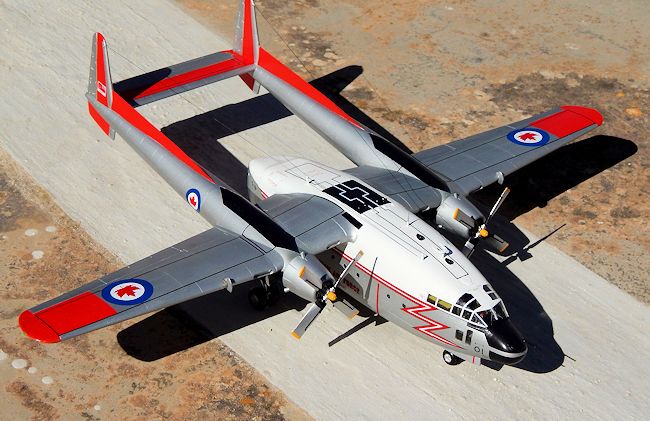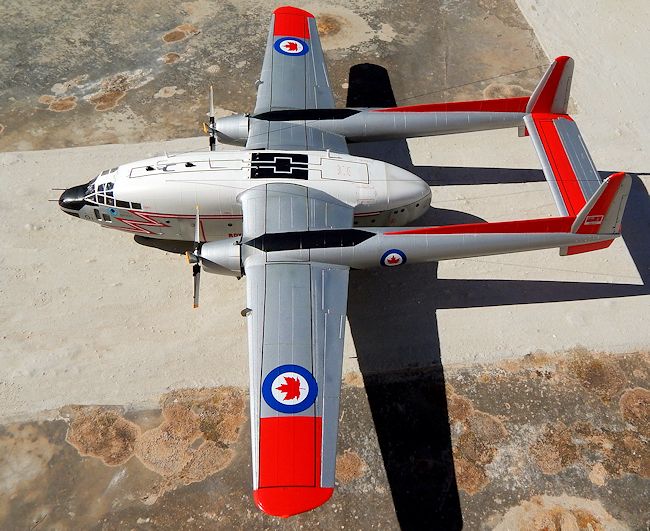Italeri 1/72 C-119G Boxcar
|
KIT #: |
146 |
|
PRICE: |
20 Euros |
|
DECALS: |
Five options |
|
REVIEWER: |
Carmel J. Attard |
|
NOTES: |
|

Developed from the C-82A Packet the Flying Boxcar was a twin boom piston engine
transport aircraft that first flew in September 1944. It featured rear opening
clam-shaped doors that allowed for easy loading at truck level. Besides Canada
no less than 10 other countries also used the Boxcar also nicknamed
Dollar-Nineteen. Production ended in 1955 after 1112 examples were produced.
The C-119F examples were ordered by the Royal Canadian Air Force who
received 35 of the type between 1952-53. This provided the RCAF with its first
heavy-lift transport capacity and supplanted the North Star in strategic airlift
role. The Flying Boxcar had the addition of a radar nose and modifications to
the propellers and in due course the CAF fleet was modernized to C-119G
standard.
 Following the transport-training unit 4(T) OUT, Boxcars were issued to
No435 (T) Squadron at Edmonton, later Namao, No 436 at Dorval, later Downsview,
and No 408 (TS&R) at Rivers. The Electronic Warfare Unit at St. Hubert also used
the Boxcar and 114 (ATU) operated from Naples (Capodichino) Italy between
November 1956 and January 1957.
Following the transport-training unit 4(T) OUT, Boxcars were issued to
No435 (T) Squadron at Edmonton, later Namao, No 436 at Dorval, later Downsview,
and No 408 (TS&R) at Rivers. The Electronic Warfare Unit at St. Hubert also used
the Boxcar and 114 (ATU) operated from Naples (Capodichino) Italy between
November 1956 and January 1957.
The Boxcar was phased out from May 1965
following Hercules deliveries. The last flight was 8th July 1967.
Surplus aircraft were stored at Saskatoon for several years until 22 were bought
by a US aerial fire-fighting operator. Some airframes received a jet pod fitted
above the fuselage for extra thrust in this role. Seven C-119s were later used
by the Moroccan Air Force. The serial range used by the RCAF was 22101-22135
(35). Only the first three aircraft had prior USAF serials of 51-2687-51-2689.
Boxcars or Packets as we better know them in Malta were common at one
time. Going back to early 60s we have seen USAF, US Marines, Indian, Italian and
Belgian Packets stopping over here at Luqa airfield on a routine stop or
training mission. I doubt if any are still flying these days. The last known
version of the type, very active during the Viet Nam war was the AC-119k, which
was an adopted gunship version.
While there are not so many who are keen on building transport type models I
happened to be one of those that transport types appeal to me most especially
now that the quality of the kits on the market have shown a great improvement.
One can easily tell this even by the example of the Fairchild Packet kits
released at the scale of 1/72. Earlier there was the Aurora kit that goes back
to the early70s. This had thick plastic section and lacked accuracy and details
as compared to the more recent kit (mid 1980s) released by Italeri. I happened
to build both kits. Further to this, the Aurora kit was issued with one USAF
 decal sheet while the Italeri one had no less than 5 decal options including
walkway markings and tiny stencil detail. Other lacking features such as lack of
wheel wells and other detail in the Aurora kit goes beyond the scope of this
review
decal sheet while the Italeri one had no less than 5 decal options including
walkway markings and tiny stencil detail. Other lacking features such as lack of
wheel wells and other detail in the Aurora kit goes beyond the scope of this
review
The Italeri kit comes in a large box that upon opening reveals high
quality parts in light gray plastic parts complete with an 8-page instruction
sheet and a large colourful decal sheet.
This offers markings for silver and Day glow orange USAF or French AF
livery; another in Italian AF dark green and gray top camouflage also with day
glow orange markings., A Taiwanese AF C-119 in 3 tone VN type of camouflage and
finally an overall silver Belgian machine with fancy nose markings.
This is a fair sized model. There is detail in the cockpit interior containing 4
crew seats, two crescent control wheels, and an instrument panel with raised
detail for easy hand painting. There is a side table for the navigator and also
other detail equipment on sides of cockpit bulkhead. Loading clamshell doors at
aft fuselage show structural detail, which is very effective if kit is assembled
with doors open. This also reveals detail at interior on fuselage sides. I found
the fit of parts very good with few areas that really require any filler.
However for the perfect smooth joint areas between w ing fairing and booms would
require a little attention.
ing fairing and booms would
require a little attention.
Being a sizeable model with some lead weight added inside the modified
nose I went for a metal undercarriage set SAC 72-011. The set provides an exact
replacement of the kit leg parts in addition to more strength and detail.
Since I have used the Leading Edge decal sheet for the Boxcar, the
different shape nose cone comes as part of the decal set kit and this comes in
resin together with the small identical antennae mounted on the rooftop. The
resin nose simply slid over the
Italeri kit nose. I hammered a solid malleable lead piece to conform to the
shape of the nose cavity that I found to be sufficient for the kit to balance on
the nose gear, which worked around a little over an ounce in weight.
As I chose to build the kit as a Canadian subject I finished with a spare
kit decal sheet. This I have used on my Aurora C-119, which although was built
some time ago did not have the complete decal set for it. This was an
opportunity to update the decals and that I did. The Boxcar was painted in
Guards red at this stage to wings and tail unit areas and after allowing
overnight for the paint to set I masked the red areas as well as the white areas
and airbrushed the rest in silver metal finish. I was very impressed at the
amount of detail and quality that Dave Koss of Leading Edge has gone to produce
this decal sheet
 The overall finish was natural metal, with upper cabin and upper fuselage
painted white and a matt black anti glare panel in front of cockpit. Standard
bright red high visibility areas were applied using Guards red over a white base
coat. Control surfaces remained natural metal. The fuselage carried a full
shadow title along with the quad-reversing fuselage flash decal. Tail fin
markings consisted of both left and right hand red ensign with the complete
serial centred under and contained in a white rectangle. Roundels were applied
on both upper surfaces of main planes. RCAF legend appear underside the
starboard wing and the last three-digit of the serial under the port wing. The
Leading Edge decal used was set 72-004. Decals were very comprehensive and have
a choice of markings for machines 22101, 22104 and 22119.
The overall finish was natural metal, with upper cabin and upper fuselage
painted white and a matt black anti glare panel in front of cockpit. Standard
bright red high visibility areas were applied using Guards red over a white base
coat. Control surfaces remained natural metal. The fuselage carried a full
shadow title along with the quad-reversing fuselage flash decal. Tail fin
markings consisted of both left and right hand red ensign with the complete
serial centred under and contained in a white rectangle. Roundels were applied
on both upper surfaces of main planes. RCAF legend appear underside the
starboard wing and the last three-digit of the serial under the port wing. The
Leading Edge decal used was set 72-004. Decals were very comprehensive and have
a choice of markings for machines 22101, 22104 and 22119.
The completed kit looked splendid and at last I have the C-119G that I
longed so much to add to my transport lot. It set quite a contrast when placed
next to my other Packet model that was camouflaged in Dark green and dark grey
upper. I enjoyed making this model, which may be a prelude for my other Boxcar
kit in my stash, the Italeri AC-119K Kit no 153.
IPMS Canada's
Random Thoughts
issues.
Carmel J. Attard
February 2014
If you would like your product reviewed fairly and fairly
quickly, please
contact
the editor or see other details in the
Note to
Contributors.
Back to the Main Page
Back to the Review Index Page



 decal sheet while the Italeri one had no less than 5 decal options including
walkway markings and tiny stencil detail. Other lacking features such as lack of
wheel wells and other detail in the Aurora kit goes beyond the scope of this
review
decal sheet while the Italeri one had no less than 5 decal options including
walkway markings and tiny stencil detail. Other lacking features such as lack of
wheel wells and other detail in the Aurora kit goes beyond the scope of this
review ing fairing and booms would
require a little attention.
ing fairing and booms would
require a little attention.